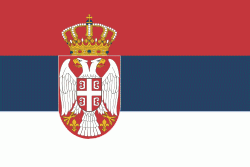Bogatić (Opština Bogatić)
Bogatić (Богатић, ) is a town and municipality located in the Mačva District of western Serbia. As of the 2011 census, it has 28,843 residents.
Bogatić is located in the western part of Serbia. The nearest large settlement is Šabac, Mačva's administrative center, located 24.5 kilometers to the east. Its distance from the capital, Belgrade, is 99.7 kilometers.
Bogatić is located along the northwestern part of the fertile and rich lands in Mačva. Two rivers flow through the town: the Drina from the west and the Sava from the north. Bogatić holds large amounts of groundwater underneath. The population heavily relies on their water supply from underground sources. A river network gravitates towards the town via the Sava, giving it the appearance of a fan with a knot when seen at Šabac. The climate in Bogatić is warm and temperate, classified as Cfb by the Köppen-Geiger system. The average temperature is 11.5 °C and precipitation averages 704 mm annually.
Bogatić is rich in geothermal springs and by the end of 2018, it should become the first town in Serbia which will use geothermal energy for district heating. The hot water (36 to 80 C) was discovered in the early 1980s. Geothermal well BB1, one of 8 dug so far, will be used. It has the capacity of 25 L/second of hot water (75 C), producing the energy equal to 63 tons of liquid fuel per day. The well is located almost in downtown, only 1.5 km from the objects that will be heated, which additionally lowers the cost of the project. For now, the heating system will include pre-schools, elementary schools, high schools, municipal and judicial buildings, communal companies and police. The pipes will be laid in the ringed system, needed to cool the water down to 55 C, but it will also allow for the future addition of other objects to the heating grid. The studies are still being conducted and the industrial complex, polyhouses and newer, energy efficient buildings might be added in the future. The final phase of the construction started on 16 July 2018.
Bogatić is located in the western part of Serbia. The nearest large settlement is Šabac, Mačva's administrative center, located 24.5 kilometers to the east. Its distance from the capital, Belgrade, is 99.7 kilometers.
Bogatić is located along the northwestern part of the fertile and rich lands in Mačva. Two rivers flow through the town: the Drina from the west and the Sava from the north. Bogatić holds large amounts of groundwater underneath. The population heavily relies on their water supply from underground sources. A river network gravitates towards the town via the Sava, giving it the appearance of a fan with a knot when seen at Šabac. The climate in Bogatić is warm and temperate, classified as Cfb by the Köppen-Geiger system. The average temperature is 11.5 °C and precipitation averages 704 mm annually.
Bogatić is rich in geothermal springs and by the end of 2018, it should become the first town in Serbia which will use geothermal energy for district heating. The hot water (36 to 80 C) was discovered in the early 1980s. Geothermal well BB1, one of 8 dug so far, will be used. It has the capacity of 25 L/second of hot water (75 C), producing the energy equal to 63 tons of liquid fuel per day. The well is located almost in downtown, only 1.5 km from the objects that will be heated, which additionally lowers the cost of the project. For now, the heating system will include pre-schools, elementary schools, high schools, municipal and judicial buildings, communal companies and police. The pipes will be laid in the ringed system, needed to cool the water down to 55 C, but it will also allow for the future addition of other objects to the heating grid. The studies are still being conducted and the industrial complex, polyhouses and newer, energy efficient buildings might be added in the future. The final phase of the construction started on 16 July 2018.
Map - Bogatić (Opština Bogatić)
Map
Country - Serbia
 |
 |
| Flag of Serbia | |
Continuously inhabited since the Paleolithic Age, the territory of modern-day Serbia faced Slavic migrations in the 6th century, establishing several regional states in the early Middle Ages at times recognised as tributaries to the Byzantine, Frankish and Hungarian kingdoms. The Serbian Kingdom obtained recognition by the Holy See and Constantinople in 1217, reaching its territorial apex in 1346 as the Serbian Empire. By the mid-16th century, the Ottomans annexed the entirety of modern-day Serbia; their rule was at times interrupted by the Habsburg Empire, which began expanding towards Central Serbia from the end of the 17th century while maintaining a foothold in Vojvodina. In the early 19th century, the Serbian Revolution established the nation-state as the region's first constitutional monarchy, which subsequently expanded its territory. Following casualties in World War I, and the subsequent unification of the former Habsburg crownland of Vojvodina with Serbia, the country co-founded Yugoslavia with other South Slavic nations, which would exist in various political formations until the Yugoslav Wars of the 1990s. During the breakup of Yugoslavia, Serbia formed a union with Montenegro, which was peacefully dissolved in 2006, restoring Serbia's independence as a sovereign state for the first time since 1918. In 2008, representatives of the Assembly of Kosovo unilaterally declared independence, with mixed responses from the international community while Serbia continues to claim it as part of its own sovereign territory.
Currency / Language
| ISO | Currency | Symbol | Significant figures |
|---|---|---|---|
| RSD | Serbian dinar | дин or din. | 2 |
| ISO | Language |
|---|---|
| BS | Bosnian language |
| HU | Hungarian language |
| SR | Serbian language |















